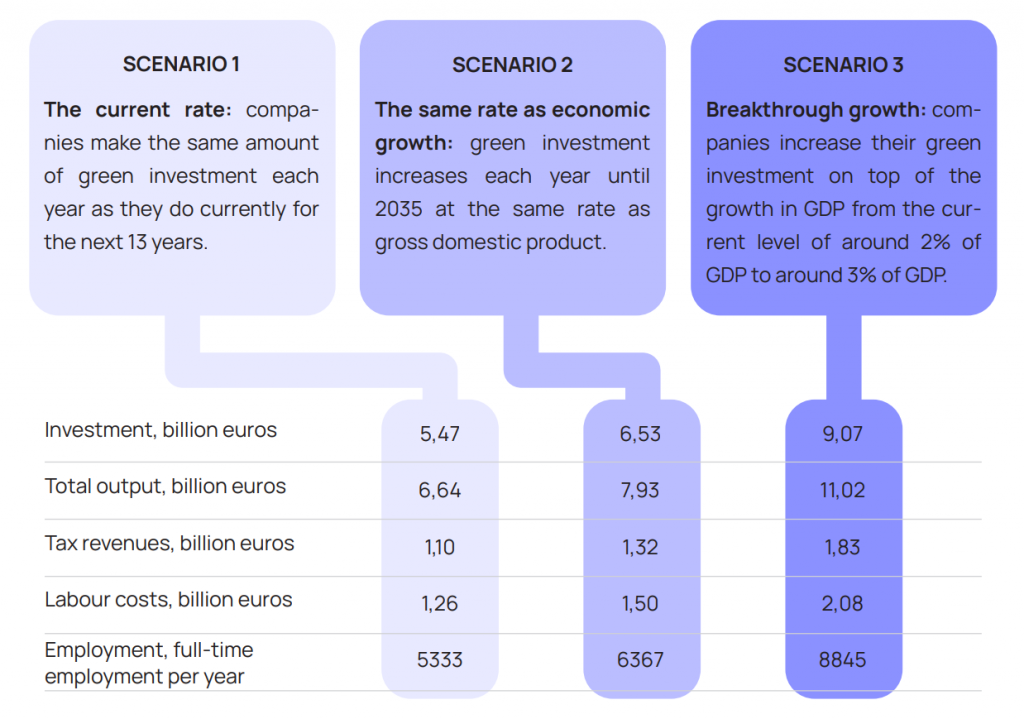The deterioration of the environment and climate warming pose significant risks to the well-being of people in Estonia. In alignment with the European Union’s green transition, Estonia has committed to achieving climate neutrality by 2050. To achieve these goals, mere improvements in existing energy systems may not suffice and fundamental changes are required in how energy is supplied to the population, and in how people move around, eat and live.
Solutions may come from breakthrough technologies and from making the whole organisation of society more sustainable, and from applying the principle of sufficiency when using resources. While some solutions are already visible today, more significant decisions lie ahead for us.
The average environmental footprint per resident in Estonia is 3.8 times the Earth’s tolerance limit, exceeding the European average by 30%, which itself is 2.9 times the tolerance limit. Electricity and heating for homes account for the largest part (43%) of the environmental footprint, followed by producing the food residents consume (30%) and transport and travel (17%). The average resident of Estonia is different to the average European resident mainly because their environmental footprint from the electricity and heating for their home is larger, and this is the first place where efforts to reduce the environmental footprint should be focused.
The environmental footprint can be reduced by developing and applying technologies that make more sustainable consumption accessible to people in Estonia. People can equally reduce their own environmental footprint, by changing their consumption behaviour and habits. For example replacing heating from stoves with district heating would reduce the environmental footprint by 15% in urban areas and by 10% in Estonia as a whole. Cutting the use of firewood in rural districts by 50% through improved building insulation or more effective heating systems could decrease the environmental footprint of those rural districts by 17%. Dietary changes, like reducing meat consumption to the levels recommended by the National Institute for Health Development, could lead to a 5% reduction in the environmental footprint. The environmental footprint can also be reduced through how people move around, and it could be cut by 3% if 20% of car journeys were replaced by public transport.
The emission intensity of the Estonian economy has fallen rapidly, but it remains 42% above the EU average. Greenhouse gas emissions from Estonia have declined by 40% over the past decade, and certain major sectors such as industry have achieved a faster decline in emission intensity, which is average emissions per million euros of value added created, compared to the EU average. The energy production sector is responsible for approximately half of Estonia’s total greenhouse gas emissions. If Estonia’s emissions from electricity production were at the average level for the European Union, its total emissions would be similar to the EU average and would already be below the target set for 2035, which is 8 million tonnes. However, the next step of moving from 8 million tonnes of greenhouse gas emissions to climate neutrality by 2050 will be a major challenge that will probably not be met by the technologies currently available on the market, but will demand new technological breakthroughs.
Many of the technologies needed for the green transition are still in the development phase. Different trends in technological development are competing for ressources available for the green transition, and in many areas, the breakthrough solution remains uncertain. Data from the International Energy Agency indicate that around half of the technology required to achieve climate neutrality is still only in the early prototype or demonstration phase.
The most impactful upcoming technologies for Estonia according to experts:

These technologies have the potential not only to address Estonia’s own challenges in the green transition, but also offer opportunities for the Estonian technology sector to develop and market their applications globally.
Estonia’s greatest opportunities lie in the development of green technology and its export to foreign markets. The experts involved in this research did not consider building factories for chips or cultivated meat in Estonia to be realistic because of the massive amount of investment required. Business opportunities in those areas will come primarily from research and development work (R&D) that aims to design technologies or products that can be exported. An exception to this is biorefining, where there are business opportunities in applying the technology locally, particularly biorefining from wood, which would extend and diversify the existing wood processing industry. Hydrogen also has the potential to become an important tradeable good for Estonia and to help offshore wind energy realise its potential of 7 GWhel and 24TWhel annual output, by offering producers marketing opportunities in central Europe and beyond, where energy shortages are forecast to increase in future.
Developing green technology needs a competitive policy of support. State support in Estonia for research and development in the private sector has been quite unstable over time, varying in the range of 6–20 million euros a year, which is considerably low on an international scale. Countries in the OECD give an average of around 0.2% of GDP in support to private sector R&D, and this is divided fairly equally between subsidies and tax benefits. Tax benefits have the advantage for companies that they are more predictable, and so they can be considered when business plans are first drawn up. Support in Estonia for private sector R&D in 2020 was only 0.06% of GDP, and there were practically no tax benefits available.
The green transition needs investment at a faster rate. To prevent environmental degradation, the technology, equipment, buildings and energy systems used in economic activities need to be modernised rapidly and in some cases they need to be replaced before they reach the end of their economic life. The estimated total annual green investment needed in Estonia is around 4% of GDP a year until 2030, 2% of GDP in 2031–2040, and up to 1% of GDP in 2041–2050. While the share of companies in Estonia involved in green investment is similar to that of the European Union, the current investment amounts fall short of meeting the required levels. Estonian companies tend to prioritize enhancing existing systems’ efficiency, whereas EU companies allocate more investment towards adopting new technologies.
Different scenarios are proposed to assess the possible future economic impact of green investment based on the rate of growth of green investment:
- Scenario 1 The current rate: companies maintain the same level of green investment annually as they do currently for the next 13 years.
- Scenario 2 The same rate as economic growth: green investment increases each year until 2035 at the same rate as gross domestic product.
- Scenario 3 Breakthrough growth: companies increase their green investment on top of the growth in GDP from the current level of around 2% of GDP to around 3% of GDP.
The amount of green investment by companies in Estonia and its impact in 2023–2035

Source: author’s calculations using the RITA-C19 macromodel based on input-output tables
The moderately optimistic Scenario 2 suggests that investing one euro in greener economic activities increases total output by 1.2 euros, while tax revenues to fund public services would increase by 20 cents.
State enterprises and private companies in Estonia have major projects at different stages of readiness that could surpass the investment volumes projected in Scenario 3, Breakthrough growth, if implemented. The investment volumes for projects in electricity production, storage and efficient use alone could reach 19.4 billion euros, significantly boosting the economy. This investment would lead to a total output increase of approximately 10 billion euros and a 3.2 billion euros rise in public sector tax revenues. Among the assessed investment projects, those with the largest economic impact involve increasing the energy efficiency of housing, building a nuclear power station, and converting heavy transport to biofuels.
Indicators for investment in the Estonian green transition

Source: author’s calculations using the RITA-C19 macromodel based on input-output tables
The beneficial impact for the Estonian economy from green investment depends very much on what share of the inputs comes from domestic sources, or how much of the green technology products and services are provided by Estonian businesses. If the share of domestic inputs used in green investments by Estonian companies were five percentage points higher than the moderately optimistic Scenario 2, and the share of imported inputs correspondingly decreased, Estonia’s total output would increase by an additional 280 million euros, and tax revenues would rise by 20 million euros beyond the projections of Scenario 2. This highlights that developing green technology would not only benefit Estonia through exports to other countries but also by utilizing more domestic technology and products in green investment, reducing reliance on imports.

 An independent think tank at the Riigikogu
An independent think tank at the Riigikogu 